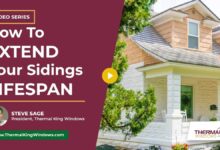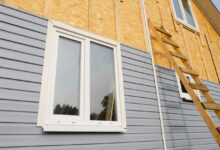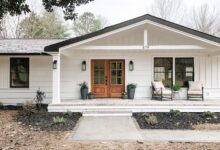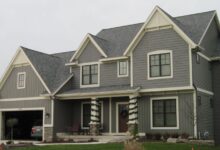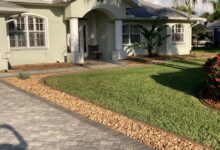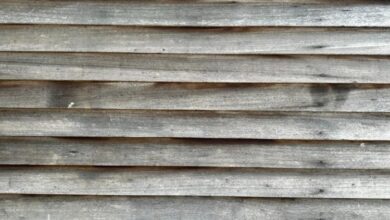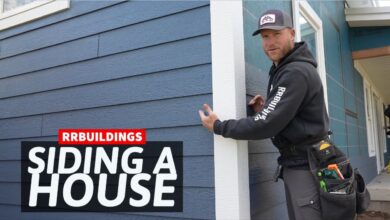Choosing the Best Siding Material for Your Climate
Choosing the Best Siding Material for Your Climate is crucial for both the longevity and aesthetic appeal of your home. The right siding not only protects your investment but also enhances your curb appeal and contributes to energy efficiency. This guide explores various siding materials – wood, vinyl, fiber cement, and metal – comparing their durability, maintenance requirements, thermal properties, and costs across different climates. We’ll help you navigate the complexities of siding selection, ensuring you make an informed decision that perfectly suits your home and local weather conditions.
From the scorching heat of deserts to the frigid blasts of winter storms, your climate significantly impacts the performance and lifespan of your home’s siding. Understanding these impacts is paramount. We’ll examine how factors like temperature extremes, humidity, rainfall, and even the potential for extreme weather events like hurricanes or wildfires influence your choice. By considering these factors, you can select a siding material that not only looks great but also withstands the test of time and protects your investment.
Understanding Climate’s Impact on Siding
Choosing the right siding material is crucial for the longevity and aesthetic appeal of your home. However, the impact of climate on siding materials is often overlooked. Different climates present unique challenges, demanding specific material properties to ensure both durability and cost-effectiveness. Ignoring these climatic factors can lead to premature deterioration, costly repairs, and ultimately, reduced home value.
Climate significantly affects siding materials through various mechanisms. Extreme temperatures, high humidity, intense sunlight, heavy rainfall, and strong winds all contribute to the wear and tear on exterior cladding. For instance, prolonged exposure to intense UV radiation can cause fading and cracking in some materials, while freezing and thawing cycles can lead to expansion and contraction, potentially causing damage to less robust sidings. Similarly, high humidity can promote the growth of mold and mildew, especially on materials that are not adequately resistant to moisture. The type and intensity of precipitation also play a vital role, with heavy rainfall and snow loads potentially causing damage to poorly designed or insufficiently durable siding systems.
Common Siding Materials and Their Climate Suitability
Siding materials vary considerably in their resistance to the various elements. Understanding these differences is essential for making an informed decision. Common siding options include wood, vinyl, fiber cement, aluminum, and engineered wood. Each material possesses unique properties that make it more or less suitable for specific climates.
Wood siding, for example, is a classic choice known for its aesthetic appeal. However, it requires regular maintenance and is susceptible to rot, insect infestation, and damage from extreme weather conditions. Therefore, wood siding may be a less suitable choice in climates with high humidity or frequent freezing and thawing cycles, unless treated appropriately and regularly maintained.
Vinyl siding, on the other hand, is a popular low-maintenance option. Its resistance to moisture, insects, and rot makes it a good choice for many climates. However, it can be susceptible to damage from hail or strong winds and can become brittle and crack in extremely cold climates. Vinyl siding’s performance in extreme heat can also be a factor, as it can expand and contract significantly.
Fiber cement siding offers a good balance of durability and aesthetics. It’s resistant to fire, insects, and moisture, making it a suitable choice for a wide range of climates. However, it is more expensive than vinyl and requires professional installation. Its weight also necessitates a robust underlying structure.
Aluminum siding is known for its lightweight nature and resistance to rust and insect damage. It is a relatively low-maintenance option and is suitable for climates with high winds, but it can dent easily and is prone to denting from hail. Its reflectivity can also impact its performance in extremely hot climates, where it may reflect too much heat, causing increased energy consumption.
Engineered wood siding combines the aesthetics of natural wood with enhanced durability. It offers better resistance to rot, insects, and moisture than traditional wood, making it a viable option for a broader range of climates. However, it still requires regular maintenance to prevent damage from harsh weather conditions. Its cost also places it in a higher price range than vinyl siding.
Siding Materials and Their Properties
Choosing the right siding material is crucial for protecting your home and maintaining its aesthetic appeal. The durability, maintenance requirements, and thermal properties of different siding options vary significantly, impacting both longevity and energy efficiency. Understanding these characteristics is essential for making an informed decision based on your specific climate and budget.
Durability of Common Siding Materials
Wood, vinyl, fiber cement, and metal siding each offer distinct levels of durability. Wood siding, while aesthetically pleasing, is susceptible to rot, insect infestation, and warping, particularly in humid or excessively wet climates. Its lifespan can range from 20 to 50 years, depending on the wood type, treatment, and climate. Vinyl siding, a popular choice for its affordability, boasts excellent resistance to moisture and insects. However, it can be prone to cracking, fading, and damage from impact. Its lifespan typically ranges from 20 to 40 years. Fiber cement siding combines the durability of cement with the aesthetic appeal of wood. It offers superior resistance to fire, rot, insects, and impact damage, resulting in a lifespan that often exceeds 50 years. Metal siding, usually aluminum or steel, provides exceptional durability and resistance to damage, with a lifespan often exceeding 50 years. However, it can dent and scratch more easily than other options.
Maintenance Requirements of Siding Materials
The maintenance demands of siding materials differ significantly. Wood siding requires regular cleaning, painting or staining every few years, and occasional repairs to address damage from weather or pests. In climates with heavy snowfall or rainfall, maintenance needs will be higher. Vinyl siding typically requires only occasional cleaning with soap and water to remove dirt and debris. However, significant damage may require replacement of individual panels. Fiber cement siding is relatively low-maintenance, requiring only periodic cleaning. While it’s resistant to damage, repairs may be necessary if impacted heavily. Metal siding is also relatively low-maintenance, needing only occasional cleaning. However, scratches and dents might require touch-up paint or panel replacement.
Thermal Properties and Energy Efficiency of Siding Materials
Siding’s thermal properties directly impact a home’s energy efficiency. Wood siding offers moderate insulation, but its effectiveness varies with thickness and the presence of an air gap. In cold climates, properly insulated wood siding can contribute to energy savings. Vinyl siding offers minimal insulation, making it less energy-efficient than other options, especially in extreme climates. Fiber cement siding offers better insulation than vinyl, but less than wood siding with proper insulation. Metal siding, due to its conductive nature, can transfer heat more readily. However, proper insulation behind the siding can mitigate this, and in hot climates, its reflective properties can help reduce heat absorption.
Comparison Table of Siding Materials
| Material | Durability | Maintenance | Thermal Properties |
|---|---|---|---|
| Wood | Moderate; susceptible to rot, insects | High; regular cleaning, painting/staining, repairs | Moderate; effectiveness depends on thickness and insulation |
| Vinyl | Good; resistant to moisture and insects | Low; occasional cleaning | Low; minimal insulation |
| Fiber Cement | Excellent; resistant to fire, rot, insects, and impact | Low; periodic cleaning | Good; better insulation than vinyl |
| Metal | Excellent; highly resistant to damage | Low; occasional cleaning | Variable; conductive but can be insulated effectively |
Climate-Specific Siding Recommendations
Choosing the right siding material significantly impacts your home’s longevity, energy efficiency, and curb appeal. The climate you live in plays a crucial role in determining which siding options are best suited for your needs. This section provides guidance on selecting siding based on specific climate conditions.
Siding Selection for Hot, Dry Climates
Hot, dry climates present unique challenges for siding. Materials should be able to withstand intense sun exposure, high temperatures, and potential for wildfires. Consider these factors when making your selection.
- Stucco: Stucco is a durable and fire-resistant material that reflects sunlight, keeping homes cooler. Its breathability helps prevent moisture buildup, a concern even in dry climates.
- Fiber Cement: Fiber cement siding offers excellent fire resistance and durability. Its non-combustible nature makes it a safe choice in fire-prone areas. Regular painting is recommended to maintain its appearance and UV protection.
- Stone Veneer: Stone veneer provides exceptional durability and fire resistance. Its natural look complements many architectural styles, and its high thermal mass helps regulate interior temperatures.
Siding Selection for Cold, Snowy Climates
Cold, snowy climates demand siding that can withstand freezing temperatures, heavy snowfall, and potential ice buildup. The material’s ability to resist moisture damage and maintain structural integrity is paramount.
- Vinyl Siding: Vinyl siding is relatively inexpensive and low-maintenance. While not as durable as other options, it’s resistant to moisture damage and is available in various colors and styles. However, it can crack or warp under extreme cold if not properly installed.
- Fiber Cement: Fiber cement siding’s durability and resistance to moisture make it a suitable choice for snowy climates. Its strength helps it withstand the weight of heavy snow accumulation. It’s more expensive than vinyl but offers superior longevity.
- Engineered Wood Siding: Engineered wood siding, treated for moisture resistance, offers a natural look and good insulation properties. It’s crucial to ensure proper installation to prevent moisture penetration and subsequent damage.
Siding Selection for Humid, Wet Climates
High humidity and frequent rainfall necessitate siding that resists moisture damage and promotes proper ventilation. Materials prone to rot or mildew should be avoided.
- Aluminum Siding: Aluminum siding is highly resistant to moisture, rot, and insect damage. Its lightweight nature makes it easy to install, and its durability ensures long-lasting performance. However, it can dent easily.
- Fiber Cement: Fiber cement’s resistance to moisture and rot makes it an excellent choice for humid climates. Its durability and low maintenance requirements make it a popular option.
- Vinyl Siding (with proper ventilation): Vinyl siding can be suitable in humid climates, provided adequate ventilation is ensured to prevent moisture buildup behind the siding. Regular cleaning helps prevent mildew growth.
Impact of Extreme Weather Events on Siding Choices
Extreme weather events like hurricanes and wildfires necessitate careful consideration of siding material selection. Resilience and fire resistance are key factors to mitigate potential damage.
For hurricane-prone areas, impact-resistant siding materials, such as fiber cement or engineered wood siding, are crucial to withstand high winds and flying debris. Proper installation is also essential to ensure the siding’s ability to withstand extreme weather conditions. Examples of hurricanes causing significant siding damage are abundant; Hurricane Katrina in 2005 resulted in widespread siding failure across affected areas, highlighting the need for robust materials and installation.
In wildfire-prone regions, non-combustible siding materials such as stucco, fiber cement, and stone veneer are preferred. These materials can significantly reduce the risk of fire spread and protect the home’s structure. The devastating Camp Fire in California in 2018 demonstrated the crucial role of fire-resistant building materials in mitigating losses, with homes clad in non-combustible siding showing significantly better survival rates.
Cost Considerations and Life Cycle Analysis
Choosing the right siding not only enhances your home’s curb appeal but also significantly impacts your long-term budget. A thorough cost analysis, considering both initial investment and ongoing maintenance, is crucial for making an informed decision. This section will delve into the financial aspects of siding selection, highlighting the importance of life-cycle costing.
The initial cost of siding varies greatly depending on the material, its quality, and the complexity of installation. However, the initial cost is only one piece of the puzzle. Long-term costs, encompassing maintenance, repairs, and eventual replacement, often outweigh the initial expenditure. Understanding these long-term costs is essential for making a financially sound choice.
Siding Material Cost Comparison
The table below provides a general comparison of the initial cost, maintenance needs, and lifespan of common siding materials. Note that these figures are estimates and can vary based on location, labor costs, and material quality. It’s always advisable to obtain multiple quotes from reputable contractors in your area for accurate pricing.
| Material | Initial Cost (per sq ft, approximate) | Maintenance Cost (per sq ft, per year, approximate) | Lifespan (years, approximate) |
|---|---|---|---|
| Vinyl | $3-$8 | $0.10-$0.50 | 20-50 |
| Fiber Cement | $7-$15 | $0.20-$1.00 | 50-80 |
| Wood | $10-$25 | $0.50-$2.00 | 20-50 (depending on type and maintenance) |
| Aluminum | $6-$12 | $0.10-$0.50 | 30-50 |
| Steel | $8-$15 | $0.10-$0.50 | 30-50 |
Life-Cycle Costing Explained
Life-cycle costing is a method of evaluating the total cost of ownership of a product or system over its entire lifespan. For siding, this includes the initial purchase price, installation costs, maintenance expenses (such as cleaning, painting, or repairs), and the eventual replacement cost. By considering all these factors, homeowners can make a more informed decision that minimizes long-term expenses.
For example, while vinyl siding may have a lower initial cost than fiber cement, its shorter lifespan and potential need for more frequent repairs could result in a higher overall life-cycle cost over 50 years. Conversely, the higher initial investment in fiber cement siding may be offset by its longer lifespan and lower maintenance requirements, leading to potential cost savings in the long run. A thorough life-cycle cost analysis helps homeowners avoid costly surprises down the line and select the siding that best aligns with their budget and long-term goals. A simple calculation might involve estimating the total cost over the lifespan of each material, dividing by the number of years, and comparing the annualized cost. This allows for a more apples-to-apples comparison of different options.
Aesthetic Considerations and Design
Choosing the right siding not only protects your home but significantly impacts its overall aesthetic appeal and market value. The interplay between siding material, color, texture, and architectural style can dramatically enhance or detract from your home’s curb appeal. Careful consideration of these factors is crucial for achieving a cohesive and visually pleasing exterior.
The selection of siding material directly influences the overall design aesthetic of a home. Different materials offer unique textural and visual characteristics, lending themselves to various architectural styles. For example, the clean lines and smooth surface of fiber cement siding often complement modern or contemporary homes, while the rustic charm of wood siding is well-suited to traditional or craftsman-style houses. The versatility of vinyl siding allows for adaptation to a wider range of styles, although careful consideration of color and texture is still necessary to achieve a harmonious look.
Siding Materials and Architectural Styles
The relationship between siding material and architectural style is significant. Consider a Cape Cod home; its classic charm is often enhanced by the use of wood clapboard siding, creating a sense of warmth and tradition. In contrast, a sleek, mid-century modern home might benefit from the clean lines and low-maintenance aspects of aluminum or fiber cement siding, often in a neutral color palette. A Victorian home, with its intricate details, might be beautifully complemented by vinyl siding that mimics the look of wood shingles, offering a balance of historical aesthetics and modern practicality. A ranch-style home, known for its simplicity, might be best suited to the smooth, uniform appearance of stucco or even painted brick. The careful selection of siding material directly contributes to the overall success of the architectural design.
Siding Textures, Colors, and Patterns
Siding materials offer a wide array of textures, colors, and patterns to suit diverse preferences and architectural styles. Wood siding, for instance, can range from smooth, painted planks to rough-hewn, textured surfaces. Vinyl siding mimics various textures, from smooth to wood grain, offering a wide array of color choices to match any style. Fiber cement siding is available in a variety of textures and colors, including those that mimic wood or stone. Stucco provides a smooth, continuous surface, available in a wide range of colors, and can be textured for added visual interest. Metal siding offers a sleek, modern look, often in metallic shades, but also available in colors that mimic other materials. The possibilities are vast, allowing homeowners to personalize their homes’ exteriors.
Impact of Siding Choices on Curb Appeal and Property Value
The choice of siding material significantly impacts a home’s curb appeal and, consequently, its market value. Well-maintained, high-quality siding enhances the overall appearance of a property, making it more attractive to potential buyers. Conversely, outdated or damaged siding can significantly detract from a home’s value and curb appeal. For instance, a home with freshly installed, attractive siding will likely command a higher price than a similar home with weathered or damaged siding. This is especially true if the siding choice complements the architectural style and landscaping of the property. Real estate agents frequently cite siding as a key factor influencing a home’s marketability and sale price, highlighting the importance of selecting a durable and aesthetically pleasing option. Studies have shown that improving the exterior of a home, including the siding, can yield a significant return on investment.
Installation and Maintenance Best Practices
Proper installation and regular maintenance are crucial for maximizing the lifespan and performance of your siding, regardless of the material chosen or the climate you live in. Neglecting these aspects can lead to premature deterioration, costly repairs, and even structural damage to your home. This section details best practices for various siding materials and climates, emphasizing preventative measures.
Siding Material Installation Techniques
The installation process varies significantly depending on the siding material. Vinyl siding, for example, typically involves overlapping horizontal planks, secured with nails or screws. Careful attention must be paid to ensuring proper overlap and alignment to prevent water penetration. In climates with extreme temperature fluctuations, using expansion and contraction allowance during installation is crucial to prevent buckling or warping. Fiber cement siding requires more precision and often necessitates specialized tools and techniques due to its heavier weight and less flexibility. Wood siding, prone to moisture damage in humid climates, necessitates the use of appropriate sealants and proper spacing for ventilation. Metal siding, often preferred in areas prone to wildfires or high winds, requires secure fastening and proper grounding to prevent damage from strong winds or lightning strikes. Each material necessitates specific tools and techniques, making professional installation often advisable.
Climate-Specific Installation Considerations
Climate plays a vital role in siding installation. In hot, arid climates, proper ventilation behind the siding is paramount to prevent overheating and the build-up of moisture. In cold, snowy climates, the use of appropriate flashing and sealants around windows and doors is crucial to prevent water infiltration and ice damming. Coastal areas, with their high humidity and salt spray, require siding materials with high resistance to corrosion and moisture damage. Areas prone to high winds require extra secure fastening and possibly the use of stronger materials. Understanding these climate-specific challenges and implementing appropriate solutions during installation is critical for long-term siding performance.
Siding Maintenance and Cleaning Techniques
Regular cleaning and maintenance are essential for extending the lifespan of your siding. Vinyl siding typically only requires occasional washing with soap and water. Power washing can be effective but should be used cautiously to avoid damaging the surface. Wood siding requires more frequent cleaning and maintenance, potentially including staining or sealing every few years, depending on the climate and type of wood. Fiber cement siding is generally low-maintenance but may benefit from periodic cleaning to remove dirt and grime. Metal siding is highly durable and requires minimal maintenance, although regular inspections for signs of corrosion or damage are recommended.
Potential Siding Problems and Solutions
Several issues can arise with siding installation and maintenance. Water damage, often manifested as rot, mold, or mildew, is a common problem, particularly in wood and fiber cement siding. Proper sealing, flashing, and ventilation can help prevent this. Cracking or warping, frequently seen in vinyl and wood siding, can be caused by temperature fluctuations or improper installation. Replacing damaged sections is usually necessary. Loose or damaged siding can result from high winds or improper installation. Re-fastening or replacing the affected sections is essential. Pest infestations, such as termites or carpenter ants, can severely damage wood siding. Regular inspections and professional pest control are crucial. Finally, paint peeling or fading can affect the aesthetics and longevity of wood or metal siding, requiring repainting or recoating. Addressing these potential problems promptly can prevent more significant and costly repairs in the future.
Final Review
Selecting the ideal siding material for your climate involves a careful consideration of several key factors: durability, maintenance, cost, and aesthetic appeal. This guide has provided a comprehensive overview of popular siding options, their properties, and their suitability for various climates. By weighing the pros and cons of each material and considering your specific needs and budget, you can confidently choose a siding solution that will enhance the beauty and protect the integrity of your home for years to come. Remember to always consult with a qualified contractor to ensure proper installation and maintenance for optimal results.
